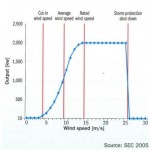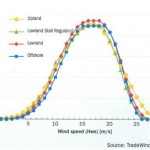Wind turbines are usually placed in clusters called wind farms, with sizes ranging from a few MW (sometimes even a single wind turbine is sold, for instance to a private investor or to give power to an energy intensive factory like a cement plant) up to several hundred MW.
These clusters are connected to the grid as single generation units, therefore the term wind plants is the best suited. Whereas initially the emphasis on wind farm design was mainly on efficient and economic energy production that respected the rules of the grid operators, nowadays, with increasing wind power penetration, the demands of the grid operators have changed.
In response to these demands, modern wind turbines and wind farms have developed the concept of the so called “wind energy power plant”. The concept is essentially a wind farm with properties similar to a conventional power plant, with the exception that the fuel injection is variable. The operation of a wind energy power plant is designed in such a way that it can deliver a range of ancillary services to the power system.
Its control system is designed such that the power can be actively controlled, including ramping up and down similar to conventional generation plants. Wind power plants can and do positively contribute to system stability, fault recovery and voltage support in the system.
The properties described above greatly enhance the grid integration capability of wind power. In order to achieve high penetration levels, active control properties are essential to optimally share the power supply tasks together with other plants and to enhance network security.
An essential difference between wind plants and conventional power plants is that the output of wind plants very strongly depends on the characteristics (mainly the local wind climate) of the site where they are installed. The rated power, also known as the nameplate power, is the maximum power, which is reached only 1% to 10% of time. Most of the time wind turbines operate at partial load, depending on the wind speed. From the point of view of the power system, wind turbines can be regarded as production assets with an average power corresponding to 20 to 40% of the rated power, with peaks that are three to five times higher.
Wind power performance indicators are related to the principal wind turbine specifications, that is rated power, and rotor diameter. The specific rated power is in the range of 300 – 500 W/m2, where the area is the “swept area” of the rotor. Wind turbine electric power output will vary with the wind: it is measured according to IEC and is graphically represented in a power curve (a graphical representation of the power output at several wind speeds).
This energy output can be standardized to a long-term (20 years) average energy output and to derive the power output in short-term forecasting from 10 minute average wind speed values produced by forecast models.
Here you have an example of range and typical values for several relevant technical characteristics both for wind turbines and wind farms:
| Wind Turbine characteristic | Range | Typical value |
| Rated power (MW) | 0.850-6.0 | 3 |
| Rotor diameter (m) | 58-130 | 90 |
| Specific rated power (W/m2) | 300-500 | 470 |
| Capacity factor onshore | 18-40 | Varies |
| Capacity factor offshore | 30-45 | Varies |
| Full load equivalent onshore | 1600-3500 | Varies |
| Full load equivalent offshore | 2600-4000 | Varies |
| Specific annual energy output (kWh/m2 year) | 600-1500 | Varies |
| Technical availability onshore | 95-99 | 97.5 |
| Wind Farm characteristic | Range |
| Rated wind farm size (MW) | 1.5-500 |
| Number of turbines | 1-hundreds |
| Specific rated power offshore (MW/Km2) | 6-10 |
| Specific rated power onshore (MW/Km2) | 10-15 |
| Capacity factor (load factor) onshore | 18-40 |
| Capacity factor (load factor) offshore | 30-45 |
| Full load equivalent onshore | 1600-3500 |
| Full load equivalent offshore | 2600-4000 |
| Technical availability onshore | 95-99 |
Sources for this post:
Powering Europe. Wind energy and the electric grid (EWEA, November 2012)
IEC, 2005 Power performance measurements of electricity producing wind turbines
TradeWind 2009. Integrating wind – developing Europe’s power market for the large-scale integration of wind power.


Leave a Reply